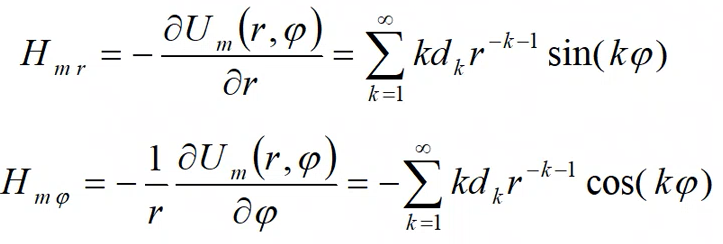
- •Лекция 1. Fundamental concepts of electromagnetics. Electrostatics. (Начало электростатики)
- •Vectors and scalar fields. (Векторные и скалярные поля)
- •Electrostatic field. (Электростатическое поле)
- •Coulomb’s Law. (Закон Кулона)
- •Electric Field Strength e and Displacement Field d. (Напряжённость и смещение электрического поля)
- •Gauss’ Law. (Закон Гаусса)
- •Electric Potential. (Электрический потенциал)
- •Work in the electric field. (Работа в электрическом поле)
- •Dielectric polarization. (Диэлектрическая поляризация)
- •Dielectric material characteristics. (Характеристики диэлектриков)
- •Properties of dielectric materials. (Свойства диэлектрических материалов)
- •Poisson’s and Laplace’ s equations. (Уравнения Пуассона и Лапласа)
- •Лекция 2. Boundary conditions for the Laplace or Poisson equations (Граничные уравнения для уравнений Лапласа и Пуассона)
- •Electrostatic Energy (Электростатическая энергия)
- •Virtual experiment. (Эксперимент по нахождению энергии системы)
- •Consequences (Следствия)
- •Continuity Equation (Уравнение непрерывности)
- •Лекция 3. Static magnetic field (Статическое магнитное поле)
- •Variables and units (Переменные и единицы измерения)
- •Main Relations (Основные соотношения)
- •Magnetic flux density (Индукция магнитного поля)
- •Biot-Savart’s law (Закон Био-Савара)
- •Ampere’s law (Закон полного тока)
- •Scalar magnetic potential (Скалярный магнитный потенциал)
- •The cut in the space (Разрез в пространстве)
- •Laplace equation for the scalar magnetic potential (Уравнение Лапласа для скалярного магнитного потенциала)
- •Vector magnetic potential (Векторный магнитный потенциал)
- •Magnetic flux (Магнитный поток)
- •Differential equation for the vector magnetic potential (Дифференциальное уравнение для векторного магнитного потенциала)
- •Gauging of the vector magnetic potential (Калибровка векторного магнитного потенциала)
- •Integral presentation of the vector magnetic potential (Интегральное представление векторного потенциала)
- •Inductance (Индуктивность)
- •Mutual inductance (Взаимная индуктивность)
- •Inductance of thin contours (Индуктивность тонких контуров)
- •Field intensity inside a cylindrical conductor (Напряжённость поля внутри цилиндрического проводника)
- •Лекция 4. Method of images (метод зеркальных изображений)
- •Equivalent charge density (эквивалентная плотность заряда)
- •Method of images for cylindrical boundaries between dielectrics (метод изображений цилиндрических границ между диэлектриками) Problem formulation (постановка задачи)
- •The inverse point (обратная точка)
- •Normal component of the field intensity (нормальная составляющая напряжённости поля)
- •Geometrical relations (геометрические соотношения)
- •Angles (углы)
- •Field induced by the line sources (поле, индуцированное линейными источниками)
- •The field sources for the external domain (источники полей для внешней области)
- •The field sources for the internal domain (источники полей для внутренней области)
- •Image method for the flat boundary between magnetic media (Метод изображений для плоской границы между магнитными носителями)
- •Equivalent magnetic charge density (Эквивалентная плотность магнитного заряда)
- •Dependence of the field intensity on the coordinate (Зависимость напряжённости поля от координаты)
- •Inductance of the two-wire transmission line per unit length (Индуктивность двухпроводной линии передачи на единицу длины)
- •Total inductance (Общая индуктивность)
- •Forces. The first line. (Силы. 1ая линия)
- •Forces. The second line. (Силы. 2ая линия)
- •Лекция 5. Solution of Laplace’s equation by separation of variables. (Решение уравнения Лапласа методом разделения переменных) Application of Laplace’s equation (Применение уравнения Лапласа).
- •Choice of a coordinate system (Выбор системы координат)
- •Variable separation in cylindrical coordinates (Разделение переменных в цилиндрических координатах)
- •Angular function (Угловая функция)
- •Radial function (Радиальная функция)
- •General solution of the Laplace’s equation in a cylindrical coordinate system (Общее решение уравнения Лапласа в цилиндрической системе координат)
- •Application of the variable separation method for the magnetic field modeling (Применение метода разделения переменных для моделирования магнитного поля)
- •Reduced scalar magnetic potential (Редуцированный скалярный магнитный потенциал)
- •Combination of scalar magnetic potential and reduced magnetic potential (Комбинация скалярного магнитного потенциала и редуцированного магнитного потенциала)
- •The scalar potential induced by the current line (Скалярный потенциал, индуцируемый линией тока)
- •The current potential in the cylindrical coordinate system (Потенциал от линии с током в цилиндрической системе координат)
- •The current potential in the complex plane (Потенциал от линии с током в комплексной плоскости)
- •Expansion of the current potential in the cylindrical coordinate system (Разложение потенциала от линии с током в цилиндрической системе координат)
- •Potentials in the problem domain (Потенциалы в проблемной области)
- •Inductance of the two-wire transmission line per unit length (Индуктивность двухпроводной линии передачи на единицу длины)
- •The flux induced by the magnetized cylinder (Поток, индуцируемый намагниченным цилиндром)
- •Лекция 6. Time dependent electromagnetic fields (Зависящие от времени электрические поля)
- •Faraday’s Law (Закон электромагнитной индукции)
- •Lenz’s Law (правило Ленца)
- •Induction by a temporal change of b (Индукция за счёт временного изменения b)
- •Induction through the motion of the conductor (Индукция за счёт движения проводника)
- •Induction by simultaneous temporal change of b and motion of the conductor (Индукция одновременным изменением во времени b и движением проводника)
- •Unipolar generator (Униполярный генератор)
- •Hering’s paradox (Парадокс Геринга)
- •Periodic electromagnetic field in the conductors. (Периодическое электромагнитное поле в проводниках)
- •Penetration of the electromagnetic field into a conductor. (Проникновение электромагнитного поля в проводник)
- •The skin effect. (Скин-эффект)
- •Poynting’s Theorem. (Теорема Пойнтинга) Electromagnetic Field Energy. (Энергия электромагнитного поля)
- •The rate of decrease of the electromagnetic field energy in a closed volume. (Скорость уменьшения энергии электромагнитного поля в замкнутом объёме)
- •Energy flows in the electromagnetic field (Поток энергии в электромагнитном поле)
- •Transmission of energy in a dc line (Передача энергии в линиях постоянного тока)
- •Transmission of energy in a dc line (Передача энергии в линиях постоянного тока)
- •The field picture near the wires with current (Картина поля вблизи провода с током)
- •Energy flows in static fields (Поток энергии в статических полях)
- •The momentum of the electromagnetic field (Момент электромагнитного поля)
- •The momentum of the electromagnetic field (Момент электромагнитного поля)
- •Лекция 8. Numerical Methods of the Electromagnetic Field Modeling. (Численные методы моделирования электромагнитного поля) Classification of the numerical methods (Классификация численных методов)
- •Classification of the problems (Классификация проблем)
- •Classification of the methods (Классификация методов)
- •Method of moments (Метод моментов)
- •Discretization of the problem domain (Дискретизация проблемной области)
- •Algebraic equation system (Алгебраическая система уравнений)
- •Finite element method (Метод конечных элементов)
- •Discretization (Дискретизация)
- •Finite functions (Ограниченная функция – отлична от нуля только в пределах треугольника)
- •Approximation of functions inside triangles (Аппроксимация функций внутри треугольника)
- •Approximation of the equation (Аппроксимация уравнения)
- •Weighted residual method (метод взвешенных невязок)
- •Galerkin method (метод Бубнова-Галеркина)
- •Weak formulation (ослабленная формулировка)
- •First type boundary conditions (Первый тип граничных условий)
- •The potential and field intensity (Потенциал и напряжённость поля)
Potentials in the problem domain (Потенциалы в проблемной области)
Inside the cylinder. General case.
|
|
Case of the line current source: (potential on the x-axes = 0)
|
|
Outside the cylinder. General case. (reduced potential) |
|
Case of the line current source: |
|
Current potential on the surface of the cylinder. |
|
Magnetic field intensity in the problem domain (Напряжённость магнитного поля в проблемной области)
Inside the cylinder. |
|
Outside the cylinder. |
|
Magnetic field intensity induced by the wire with the current (Напряжённость магнитного поля, индуцируемого проводом с током)
Radial component of the field intensity induced by the current line at the cylinder surface |
|
Angular component of the field intensity |
|
The field intensity induced by the current line may be calculated directly:
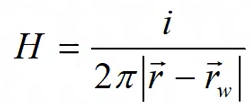
Definition of coefficients (Определение коэффициентов)
The above general relations are used for definition of coefficients.
At the surface of the cylinder:
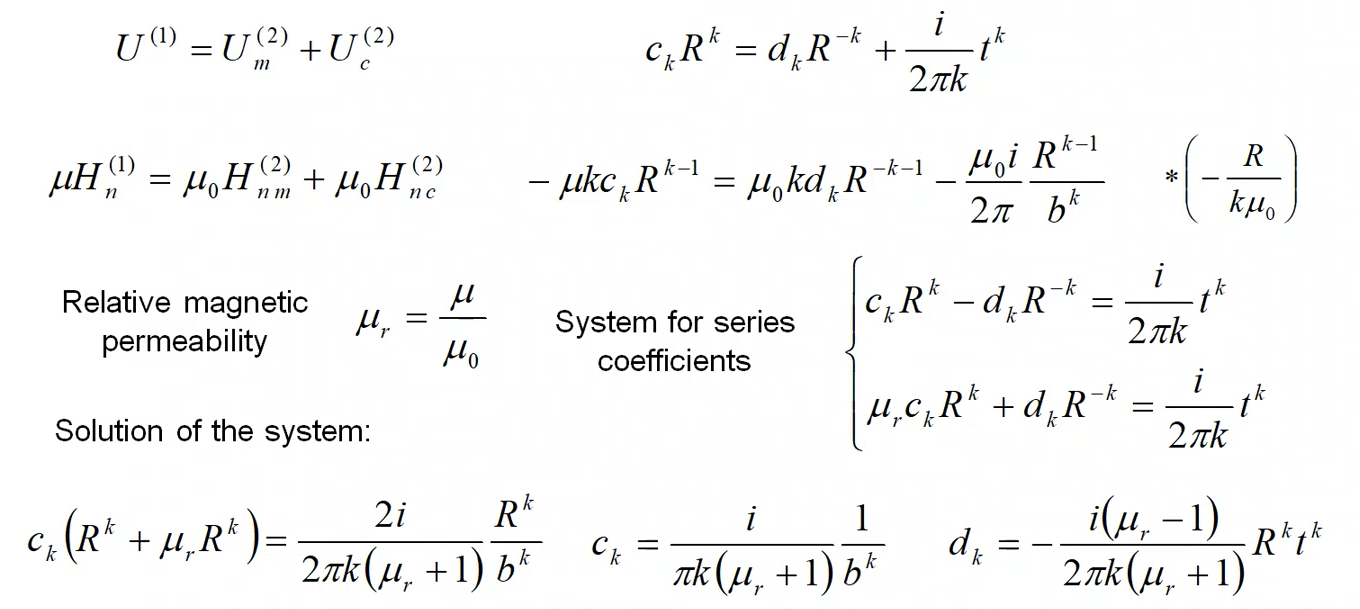
Solution of the problem (Решение задачи)
After substituting this solution into the expression of potential, we will have a scalar potential and reduced potential:
Scalar potential: |
|
Reduced potential: |
|
Magnetic field on the system axis (φ = 0):
For total magnetic field inside the cylinder:

For reduced magnetic field outside the cylinder:
Magnetic field directions (Направления магнитного поля)
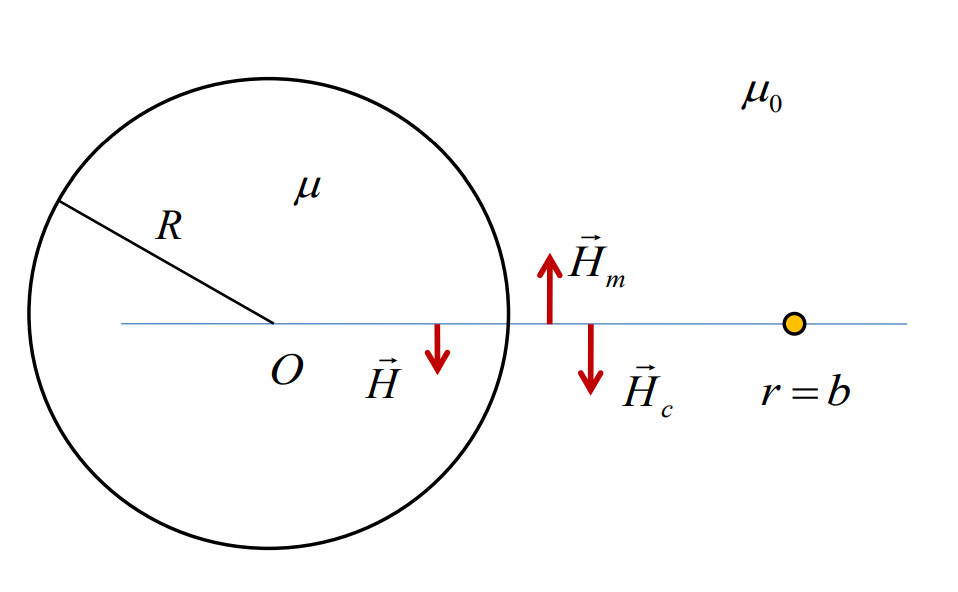
Let’s
assume that there is a current which comes to us. Then the direction
of
 will be downward and this
at the axes is an angular component of the magnetic field which is
induced by the wire. The total magnetic field
will be downward and this
at the axes is an angular component of the magnetic field which is
induced by the wire. The total magnetic field
 inside the cylinder should have the same direction, but much smaller
than
.
inside the cylinder should have the same direction, but much smaller
than
.
 is the reduced magnetic field, it also has only one angular
component, the magnitude of this vector approximately the same as
.
The difference between them is very small in the vicinity
(окрестность) of this surface.
is the reduced magnetic field, it also has only one angular
component, the magnitude of this vector approximately the same as
.
The difference between them is very small in the vicinity
(окрестность) of this surface.
Inductance of the two-wire transmission line per unit length (Индуктивность двухпроводной линии передачи на единицу длины)

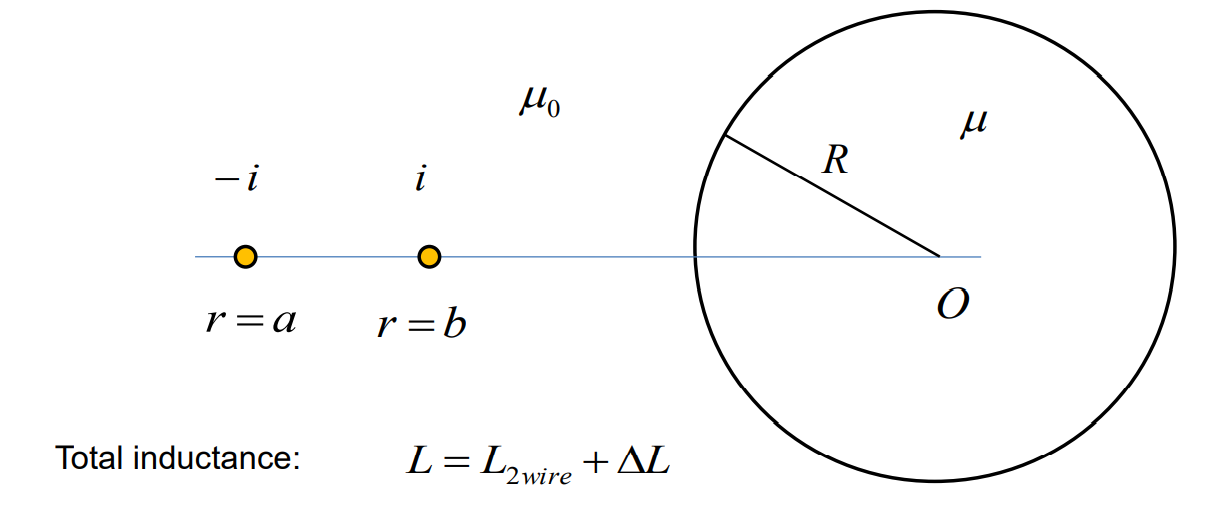
Total inductance: L L2wire L, L – additional inductance, it is induced by this cylinder.
L2wire is the inductance of 2-wire line without a cylinder
The flux induced by the magnetized cylinder (Поток, индуцируемый намагниченным цилиндром)
The flux induced by magnetized cylinder:

After integrating and substitution:
Additional inductance for the current line:
|
|
Additional inductance for the two-wire current line:
|
|
Лекция 6. Time dependent electromagnetic fields (Зависящие от времени электрические поля)
The basement of the theory of time dependent electromagnetic fields – the Faraday’s Law.
Faraday’s Law (Закон электромагнитной индукции)
The Faraday's Law links together these two sides of one electromagnetic field: magnetic field, from one side and electric field, from the another side. The Faraday’s Law is based on Maxwell equations system. The main idea of this law is: the magnetic field which depends in time, induces some electric field.
The origin of the induced voltage: - time varying magnetic fields;
- moving of the coil in stationary magnetic field.
This interaction between electric field and magnetic field finally induces, for example – electromagnetic wave. In this process (electromagnetic wave) it is important to consider together the Faraday’s Law and very special form of the Ampere’s Law. Ampere’s Law at some stage also tells us that, the time dependent electric field may induce magnetic field. But today the main part of the electromagnetic field theory is the Faraday’s Law.
The Faraday’s Law describes several processes, which takes place in electromagnetic systems. For example: if we have static system, which configuration is stable, doesn’t dependent on time, in principle in such electromagnetic system, the electric voltage may be induced or electric field may be induced, if the magnetic field changes in time. On the other hand, the opposite situation is possible: the magnetic field doesn’t dependent on time, nevertheless the electric field and the voltage, which is induced in some contour will be induced. That is possible if the contour, where we consider the voltage or electric field has unstable shape, shape may depend on time. Or this contour has a stable shape, but the contour itself moves in the external magnetic fields. These two sides of the same law, the Law which calls Faraday’s Law. They’re also very important parts of the Faraday’s Law, so called Lenz’s Law.







